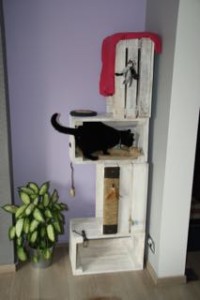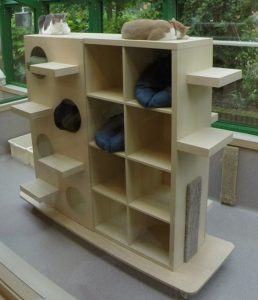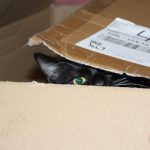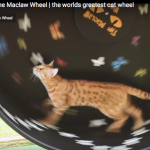Indoor cats with too little to do, can develop behaviour problems such as aggression toward the owner, fur pulling, attention seeking, spraying or overeating. These are the visible symptoms of boredom. The less obvious symptom of boredom is lethargy – they stop doing anything much. The quality of your indoor cat’s life will depend on how far you give it the chance to do natural cat behaviour (Adamelli et al., 2005).
Two cats, from kittenhood onwards only, are better than one, if the cats are indoors all the time. A sensible suggestion is that a three bedroomed house shouldn’t have more than two or perhaps three cats so don’t fill up the house with too many (always tempting!). The more cats you have in the house, the more likely you are to have problems with aggression or spraying.
If cats are sharing space, they should be able to maintain a distance of at least 1-3 metres apart from each other at all times (Barry & Crowell-Davis 1999). This is a minimum: too little space means more stress (Loberg & Lundmark 2016). They also need safety screens for balconies and open windows (Riccomini, 2012). There should also be a litter tray for each cat and one over: not enough litter trays causes stress.
Read my cat introduction article if you decide to add a new cat because just adding an unrelated cat isn’t always helpful. You may think your cat needs a friend, but cats usually don’t like new unrelated cats being imposed on them. Remember indoor cats have fewer places to go to avoid cats they dislike so it doesn’t always work out for the best. It is unfair to force incompatible cats to live in a small area.
People moving from a house to a flat may have to turn an outdoor cat into an indoor cat. This will probably work out fine if the cats are 10 years or older. Older cats don’t do so much anyway. Cats that don’t go out much anyway may also adjust well. Try the change and see what happens. If you are a real cat lover, you will know if the cat is miserable.
The cats that won’t be happy are the young, the energetic and the determined hunters. By all means see if these will adapt, but you may find that they don’t. In this case, a good charity like Cats Protection can find them a new home and probably find you a cat that needs to live indoors – elderly, handicapped or FIV positive. Good DIY tips on how to build a better home for your cat here.
Here are some suggestions on how to stimulate and enrich an indoor cat’s environment. Every cat is an individual so you will have to do what your cat enjoys. Not all these ideas will work for every cat.
1. PLAY WITH YOUR CAT.
Play is better than cuddles. A cat needs to work off his predatory instincts in play. Cats often won’t play on their own. They prefer games with humans. Buy him a fishing rod toy or make one with bamboo, sticking paper and string. Tie a piece of string to your belt so it trails behind you everywhere you go, so he can pounce on it. Throw corks, balls of paper or kitchen foil for him. At least one play session every day, preferably two or three. In the wild a cat would hunt about 10 mice a day, so aim at 10 short games or 30 pounces every day. Cats that are played with longer are less likely to have behaviour problems (Strickler & Shull, 2014).
A signal for stopping play sessions will be useful too. It will allow you to stop games that seem to be getting out of hand.
If you find it difficult to interest your cat, tie pieces of meat on string. This should do the trick! Some people get their cat to chase a light reflection from a laser pen. Once a week or so this is fine but a cat can get addicted to this and become very frustrated since there is nothing for it to catch. The chase instinct is never switched off by a kill, so to speak. So try to end a laser chase with a treat. Sometimes light chasing may become a behaviour problem in its own right. Do not do too much of this.
Make sure your cat can look out of the window. Window sills are great places for cats to sit or sleep (Loveridge 2012) and watch (Shyan-Norwalt 2005). Provide sitting places on ledges and shelves with the best view — ie. with things going on like passersby, dogs, wildlife, other cats – as long as your cat isn’t frightened by them. Put a bird feeder up for him to watch. You can buy feeders which stick to the glass or just place food on a windowsill. Warning – some cats find this frustrating rather than pleasurable, so it won’t suit every cat. Think about adding a catio if you have a garden.

ProtectaPet catio
3. SCRATCHING POSTS
One scratching post is not enough for an indoor cat. Put several, one in each room. Try mixing the rope covered ones with the cardboard paper ones. At least one should be upright high enough for the cat to scratch at full height standing on its hind legs. But with more than one you could add a paper horizontal one – sold by Oscars pet food. Wall mounted or flat scratch pads available from www.squarecathabitat.com Details of how to make your own scratching post can be found here.
Different textures like sizal, cardboard, carpet and wood will give pleasure (Rochlitz 2005). Put them in more than one room. Remember the more torn and ragged the surface, the better it is for the cat.
Spray with catnip spray, if your cat needs encouragement and if it is sensitive to catnip. Consider buying a post with a carpet lined hidey hole higher up. Cats are particularly fond of being high up. Position it so the cat can see out of the window. It will also give expression to its climbing skills. There are wonderful though expensive cat aerobic centres in pet shops and online. The best ones can be ordered but are usually not in stock. Very large cat aerobic centres will need fixing to the ceiling to get enough stability or use wall brackets. Unstable ones will not be used by your cats.
4. HIGH PLACES AND HIDEAWAYS
 Cats like looking down on us and feeling safe while they do so. Supply shelves to sit on at various heights, with different textures – fleece, carpet, rush matting (McCune 1995). You can put little shelves up to a high shelf, using small pieces of shelf, so they can leap up one by one. For descent there should be enough shelf to go down in jumps of 45 degrees and 120 cm distance. The surface must not be slippery. This is almost as good as having their own tree indoors. Aim at a vertical complexity (Rochlitz 2005). Big cats in zoos, for example, only use part of their enclosures because some space just isn’t interesting to them (Lyons et al., 1997). The photo (left) shows cat furniture made out of wooden boxes, giving height and enclosed sitting places. Wall mounted shelves are available from www.squarecathabitat.com There is an inspirational video here of a man who has converted his whole home into a super cat maze. The best bit about his house is not the walkways but the way cats can avoid each other on the maze with the help of little hideaways. Face to face encounters on a narrow walkway might be stressful so make sure there are passing places! There are some nice cat climbing towers here
Cats like looking down on us and feeling safe while they do so. Supply shelves to sit on at various heights, with different textures – fleece, carpet, rush matting (McCune 1995). You can put little shelves up to a high shelf, using small pieces of shelf, so they can leap up one by one. For descent there should be enough shelf to go down in jumps of 45 degrees and 120 cm distance. The surface must not be slippery. This is almost as good as having their own tree indoors. Aim at a vertical complexity (Rochlitz 2005). Big cats in zoos, for example, only use part of their enclosures because some space just isn’t interesting to them (Lyons et al., 1997). The photo (left) shows cat furniture made out of wooden boxes, giving height and enclosed sitting places. Wall mounted shelves are available from www.squarecathabitat.com There is an inspirational video here of a man who has converted his whole home into a super cat maze. The best bit about his house is not the walkways but the way cats can avoid each other on the maze with the help of little hideaways. Face to face encounters on a narrow walkway might be stressful so make sure there are passing places! There are some nice cat climbing towers here
Cat ladders are common in Switzerland for cats in upstairs flats. They consist of a suitable length plank about 15 cm wide with cross pieces of wood attached at 10-12 cm apart to make steps. These cross pieces are usually about the width of the plank and 2cm x 2cm in section. You may be able to give your cat a cat flap after all. Google “cat ladders” for ideas. Or use one of these ladders within your flat to give your cat access to a high sitting place.

Really clever idea – make individual resting places from IKEA shelving by adding extra partitions (Desforges et al 2016). Copyright WALTHAM Centre for Pet Nutrition, Mars Petcare
5. HIDING PLACES
Cats like to hide particularly at times when they are worried by other cats or humans (Carlstead et al., 1993). Supply cardboard boxes and large paper bags (plastic ones aren’t safe). Cut holes in the boxes for entrances and windows. Don’t put we food into cardboard boxes, as the glue in the cardboard may stick on your cat. Boxes are particularly good for cats that may want privacy from other household cats (Rochlitz, 2005). They are also fun. Or just adapt an IKEA cupboard (see photo on left) to make individual sleeping places.
6. TOYS
These don’t have to be expensive. Corks from wine bottles, scrunched up paper balls, the inside of celotape rolls, home made stuffed mice etc are all good toys. Grow catnip and stuff them with it. Knit a catnip ball – pattern here. Keep them light and easy to move about. A dried broad bean on a wood surface makes a good toy. Dangle ropes (hemp not plastic) from a hook in the ceiling. Cardboard boxes with holes to get into. Newspapers to tear. Ping pong balls in the bath. Suspend toys from a string.
Bought toys include crinkle bags, fur covered mice, etc. The shape (ie like a mouse etc) won’t influence the cat as much as its texture and ability to be moved around. There are some good commercial cat toys from Pet Planet in the UK. Have four boxes of toys and use one box per week. A new toy interests a cat more than a familiar toy (Hall et al. 2002) Keep changing the toys weekly.
7. SMELLS AND SIGHTS.
Catnip works well and stimulates play behaviour (Ellis & Wells 2010), though not all cats respond to it. Cinnamon has been used for zoo cats so might be worth trying (Resende et al., 2007). Videos of prey or wildlife may interest some cats (Ellis & Wells, 2007). Fresh grass grown in pots (either bought or dug from the garden) will be acceptable. Be cautious about house plants as some are poisonous. There are even classes for cat scentwork – www.scentworkcats.com

Home made version of a puzzleboard – copyright Mayhew Animal Home
8. MAKING FOOD INTO FUN
Give food little and often in different locations. If cats were in the wild they would have to stalk and hunt for food. “Get rid of the food bowl,” says Professor Peter Neville, pet behaviour counsellor. “Make the cat work for its food.” Hide dry food round the house or, if using wet food, hide the food bowl daily so the cat has to hunt for it (Ellis 2009, Dantas et al., 2016).
Zoo animals often prefer to work for their food and will ignore free food in favour of food they have to hunt for (Inglis et al., 1997). Cats need a bit more incentivizing! In zoos the smaller cats are more active if they have to search for their food (Shepherdson et al.,1993). One zoo which has a cat colony in an enclosure hung bits of sirloin from the roof. This created a lot of interest but they had to hang several pieces otherwise some of the cats would monopolise the single steak (Damasceno & Genaro 2014).

The Fun Board Video here.
Take a toilet roll and make large holes in it, then stop both ends with parcel tape. Put in dry food or treats – good ones. Teach the cat that if they push it, food falls out. Then make another roll with smaller holes. Once you have taught the cat that it can extract food from a dispenser, you can make other dispensers (see the photos at the top of this article). Or buy special food balls the play-n-Treat ball, filled with food. If you have a small cat make sure the dispensers are not too heavy. Kinder Surprise also make good food dispensers (see http://www.youtube.com/watch?v=kGrnFCCjI9w)
Puzzle boards where food it put into little bowls etc. are also now available (Overall & Dyer 2005). Some commercial ones may be too small for a large cat with big paws but you can make your own with an ice cube tray. There’s also something called the Delidome which shoots food out in some way – not yet seen one in action. More ideas here. Make a snuffle mat for hiding treats – instructions here. More food puzzles here.
Remember that clean drinking water is particularly important for indoor cats. They can’t go outside and find water in a puddle! The water bowl should not be next to the food bowl – it’s unnatural for cats to drink and eat at the same place and same time like humans do (Riccomini, 2012). Give them more than one water bowl, as cats like choice. Think about buying a cat fountain for your indoor cat. Some cats like to play with water.

Interactive feeder from here
9. MAKE A FOOD POLE.
Graham Law of The Institute of Biodiversity, part of Glasgow University, invented a tiger pole up which zoo tigers had to climb in order to find food. This was a telegraph pole with a chicken or hunk of meat at the top (Law 2013). The idea was to give the tigers exercise and also to give them more interesting meal times! Subsequently he invented a scaled down version for domestic cats kept indoors (see photo at the left). This is a square pole with an old washing line (sisal not plastic) wrapped round it. A plastic bowl, with a hole cut in the bottom, is fixed near the top of the pole. The cat scrambles up the pole and has to hook out cat biscuits from the bowl. This will help your indoor cat develop muscle and (just as importantly) have fun trying to get at the food.
10. FRANTIC BOX AND OTHER BOXES.
Take a large cardboard box and put shredded newspaper, newspaper balls etc. into it. In the bottom put some dry food pellets. Encourage your cat to use it as a place to play. Cats enjoy jumping into boxes. This gives your cat an alternative play area and she may spend less time shredding the wallpaper! Any time you have an unwanted box put it out for the cat before you recycle it.
11. CHOICE: MORE THAN ENOUGH OF EVERYTHING
Cats like choice. Being able to choose where they eat, sleep etc. is important to them. Make sure there is more than enough of everything – scratching posts, beds (two beds one high one low per cat is one suggestion (Rochlitz 2005)), litter trays (one per cat in different locations), water bowls in different location, several feeding stations etc.
TRAINING AND TRICKS
Yes you can teach your cat games and tricks. It’s fun for both of you. It provides mental and physical activity and is particularly useful for cats that are frustrated (Gourkow and Philips 2016). Even rotten trainers like me can train a few trick – look here. If I can do it, anybody can do it! There’s Clicker Training for Cats, by Karen Pryor. Ringpress/Interpet. Using a clicker you can train your cat over an agility course. There a Facebook page here. See also www.clickertraining.com

Wheels from http://www.maclawwheel.co.uk/
13. WHEELS
There are now running wheels for cats. They are expensive and perhaps not all cats will enjoy them. So take your time in making any decision. However odd it seems, running wheels are enjoyed not just by hamsters but by many other captive animals (Sherwin 1998). In the UK look at this website.
HOUSE CAT BOOKS AND EQUIPMENT.
The Trainable Cat by John Bradshaw and Sarah Ellis is a must buy for those wanting to train! My own book Cats Behaving Badly has some useful ideas too.
Cat screens to let in air. Cataire Screening for windows, www.cataire.co.uk Also www.flyguard.co.uk
Modular cat wall – a DIY option here. There are classes for owners who want to give their cats a nearly full hunting experience (with scent not prey) at https://www.noseworkcats.com
REFERENCES
Adamelli, S., Marinelli, L., Normando, S. & Bono, G., (2005), ‘Owner and cat features influence the quality of life of the cat,’ Applied Animal Behaviour Science, 94, 89–98
Barry, K. J., & Crowell-Davis, S. L., (1999), ‘Gender differences in the social behavior of the neutered indoor-only domestic cat’, Applied Animal Behaviour Science, 64, 193-211.
Carlstead, K., Brown & J. L. & Strawn, W., (1993), ‘Behavioral and physiological correlates of stress in laboratory cats’, Applied Animal Behaviour Science, 38, 143-158.
Damasceno, J. & Genaro, G., (2014), ‘Dynamics of the access of captive domestic cats to a feed environmental enrichment item,’ Applied Animal Behaviour Science, 151, 67-74
Dantas, L., Delgardo, M. M., Johnson, I & Buffington, C.A. T, (2016), ‘Food puzzles for cats. Feeding for physical and emotional wellbeing, Journal of Feline Medicine and Surgery, 18, 723-732
Ellis, S., (2009), ‘Environmental Enrichment. Practical strategies for improving feline welfare,’ Journal of Feline Medicine and Surgery, 11, 901-912.
Ellis, S.L. H. & Wells, D. L., (2008), ‘The influence of visual stimulation on the behaviour of cats housed in a rescue shelter,’ Applied Animal Behaviour Science, 113, 166-174.
Ellis, S.L. H. & Wells, D. L., (2010) The influence of olfactory stimulation on the behaviour of cats housed in a rescue shelter,’ Applied Animal Behaviour Science 123, 56–62
Gourkow, N. & Philips, C.J.C, (2016), ‘Effect of cognitive enrichment on behavior, mucosal immunity and upper respiratory disease of shelter cats rated as frustrated on arrival,’ Preventive Veterinary Medicine, 131, 103-110.
Hall, S. L., Bradshaw, J. W. S. & Robinson I. H., (2002), ‘Object play in adult domestic cats: the roles of habituation and disinhibition,’ Applied Animal Behaviour Science, 79, 263-271.c
Inglis,I. R., Forkman, B. & Lazarus, J., (1997), ‘Free food or earned food? A review and fuzzy model of contrafreeloading,’ Animal Behaviour, 53, 1171–1191
Law, G.,(2013), ‘Environmental enrichment for captive large cats,’ ICatCare Conference 2013, 27-29
Loberg, J. M. & Lundmark, F. (2016), ‘The effect of space on behaviour in large groups of domestic cats kept indoors,’ Applied Animal Behaviour Science, 182, 23-29.
Loveridge, G.,(2012) ‘Comfortable Environmentally Enriched Housing for Domestic Cats.’ Available at http://abanimals.awionline.org/pubs/cq/cats.htm Downloaded August 14 2012.
Lyons, J., Young, R. J. & Deag, J. M. (1997), ‘The Effects of physical Characteristics of the Environment and Feeding Regime on the Behavior of Captive Felids,’ Zoo Biology, 16, 71-83.
McCune, S., (1995), ‘Enriching the environment of the laboratory cat, in eds. Smith, C.P. and V. Taylor (September 1995). Environmental Enrichment Information Resources for Laboratory Animals: 1965 – 1995: Birds, Cats, Dogs, Farm Animals, Ferrets, Rabbits, and Rodents. AWIC Resource Series No. 2., Beltsville, MD. U.S. Department of Agriculture, and Potters Bar, Herts, UK, Universities Federation for Animal Welfare (UFAW), 27-42. Also available at http://www.nal.usda.gov/awic/pubs/enrich/labcat.htm
Downloaded August 14 2012.
Overall, K. l., & Dyer, D., (2005), ‘Enrichment Strategies for Laboratory Animals from the Viewpoint of Clinical Veterinary Behavioral Medicine: Emphasis on Cats and Dogs,’ ILAR Journal, 46, 202-216.
Resende, L de S., Gomes, K. C. P., Andriolo A., Genaro, G., Remy, G. L. & Ramos Junior, V. de A., ‘Influence of Cinnamon and Catnip on the Steriotypical Pacing of Oncilla Cats (Leopardus tigrinus) in Captivity,’ Journal of Applied Animal Welfare Science, 14, 247-254
Riccomini, F., (2012) ‘An indoor only lifestyle or access to the great outdoors – what are the welfare implications for our cats?’ APBC 2nd Annual Feline Conference Proceedings, 9-16
Rochlitz, 1. (2005), ‘A review of the housing requirements of domestic cats ( Felis silvestris catus) kept in the home, ‘ Applied Animal Behaviour Science 93, 97–109.
Shepherdson, D. J., Carlstead, K., Mellen, J. D. & Seidensticker, J., (1993), ‘The Influence of Food Presentation on the Behavior of Small Cats in Confined Environments,’ Zoo Biology, 12:203-216.
Sherwin,C. M. (1998), ‘Voluntary wheel running: a review and novel interpretation,’ Animal Behaviour, 56, 11-27
Shyan-Norwalt, M. R., (2005), ‘Caregiver Perceptions of What Indoor Cats Do “For Fun’,’ Journal of Applied Animal Welfare Science, 8, 119-209.
Strickler, B. L. & Shull, E. A., (2014), ‘An owner survey of toys, activities, and behavior problems in indoor cats,’ Journal of Veterinary Behavior, 9, 207-214.